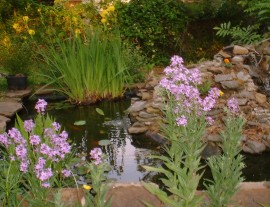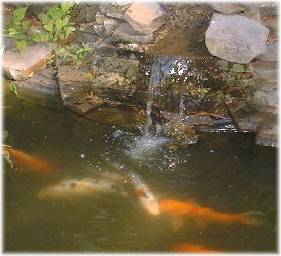 A
Backyard Habitat is simply
a space with a combination of food, water, shelter, and plants in a configuration
conducive to the needs of wildlife. The plants chosen, from tree to
soil, will determine the types of wildlife that frequent the area.
Once established, the habitat can be enhanced with bird houses, bat houses,
frog houses, or whatever is dictated.
A
Backyard Habitat is simply
a space with a combination of food, water, shelter, and plants in a configuration
conducive to the needs of wildlife. The plants chosen, from tree to
soil, will determine the types of wildlife that frequent the area.
Once established, the habitat can be enhanced with bird houses, bat houses,
frog houses, or whatever is dictated.
When planning a Backyard Habitat, please look around first. It only takes
a minute to salvage a useful plant before banishing it forever, and there
are many herbs and other plants that may be mistaken for weeds or undesirables.
Every element in the landscape has to be considered when building a habitat,
from the trees down to the turf. Trees and shrubs can be used for food and
shelter, and low-growing ground covers can support the organisms that live
in the soil. Flowers and herbs can attract bees, butterflies, and
beneficial insects. Water is the key, however. No water source
equals a serious reduction in wildlife habitation.
 The
purpose of this page is to explore the mechanics of building a first-class
backyard habitat, with a discussion of the turf, plants, shrubs and trees
needed to attract the desired wildlife.
The
purpose of this page is to explore the mechanics of building a first-class
backyard habitat, with a discussion of the turf, plants, shrubs and trees
needed to attract the desired wildlife.
This section is still in development, but check the links in the sidebar
on the left for in-depth descriptions of plants that attract bees,
butterflies, and beneficial insects, and for links with additional source
and informational material.
 A
Backyard Habitat is simply
a space with a combination of food, water, shelter, and plants in a configuration
conducive to the needs of wildlife. The plants chosen, from tree to
soil, will determine the types of wildlife that frequent the area.
Once established, the habitat can be enhanced with bird houses, bat houses,
frog houses, or whatever is dictated.
A
Backyard Habitat is simply
a space with a combination of food, water, shelter, and plants in a configuration
conducive to the needs of wildlife. The plants chosen, from tree to
soil, will determine the types of wildlife that frequent the area.
Once established, the habitat can be enhanced with bird houses, bat houses,
frog houses, or whatever is dictated. The
purpose of this page is to explore the mechanics of building a first-class
backyard habitat, with a discussion of the turf, plants, shrubs and trees
needed to attract the desired wildlife.
The
purpose of this page is to explore the mechanics of building a first-class
backyard habitat, with a discussion of the turf, plants, shrubs and trees
needed to attract the desired wildlife.